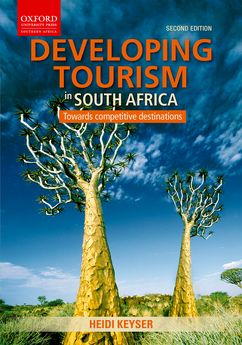What is sustainable tourism development? What gives one destination a competitive advantage over another? How can a destination exercise responsible tourism? Developing tourism in South Africa: Towards competitive destinations second edition explores the ability of countries and tourism destinations effectively to develop and manage tourism, provide satisfactory visitor experiences, and conduct tourism in an economically, socially, and environmentally sustainable manner. Tourism is already a major contributor to gross domestic product (GDP) in South Africa. However, future success will require that role players and stakeholders grow the sustainability and
competitive advantage of the destination.
Features
- Destination examples, which focus on real-life application scenarios and
- Definition boxes to clarify new or unfamiliar terms.
- A destination toolkit feature, containing hints and tips to help manage a destination effectively.
- Impact indicator boxes, highlighting indicators which act as yardsticks for the consequences of tourism, as well as destination competitiveness.
- Mind maps, providing an overall structure and indicating the interrelation between chapters.
- To do boxes, containing useful activities for readers.
- Information boxes, which add interesting, additional or explanatory information.
- A comprehensive glossary for quick revision, as well as lists of recommended reading and websites to guide further study and
information-gathering.
Part I Key concepts in tourism, development and destination competitiveness
1Tourism, development and destination competitiveness
2Understanding tourism
Part II Analysing the tourism destination
3Unpacking the tourism destination
4Contextualising the tourism destination
5Examining destination management
6Understanding the tourism industry
7Assessing destination market position
8Understanding travel patterns and trends
9Evaluating the economic impacts of tourism
10Assesssing the environmental impacts of tourism
11Examining the social and cultural impacts of tourism
(On OUPSA website)
Part III Implementing management actions for competitiveness
12 Devising destination management actions
Glossary
Index


